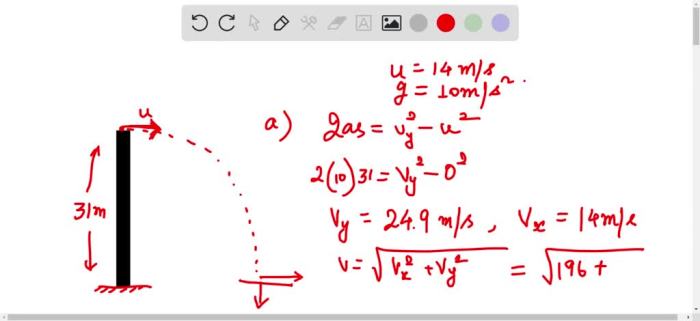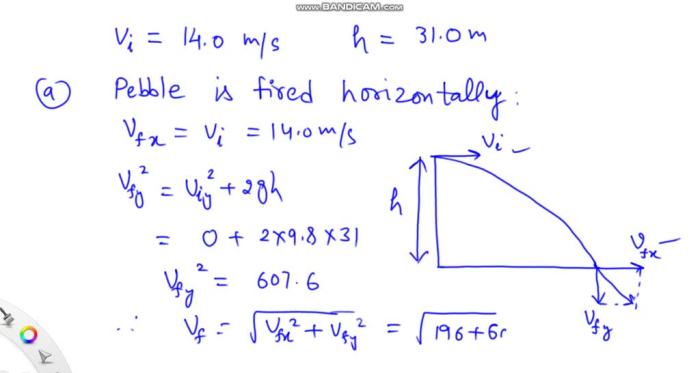A slingshot fires a pebble, launching it into a trajectory that is both graceful and powerful. This seemingly simple act involves a complex interplay of physics, skill, and tradition.
From the humble beginnings of hunting and self-defense to the modern applications of recreational shooting and pest control, the slingshot has played a significant role in human history. In this exploration, we will delve into the fascinating world of slingshots, examining their design, construction, and the techniques used to fire them.
We will also discuss the safety precautions that must be taken when using a slingshot, as well as the legal regulations and responsible use of these powerful tools.
Trajectory of a Pebble Fired from a Slingshot

When a pebble is fired from a slingshot, it follows a parabolic trajectory due to the combined effects of initial velocity and gravity. Understanding the principles of projectile motion is crucial for predicting the trajectory and optimizing the aim.
Factors Affecting the Trajectory
The trajectory of a pebble fired from a slingshot is influenced by several factors:
- Initial Velocity:The initial velocity imparted to the pebble determines the distance and height it will travel.
- Angle of Release:The angle at which the pebble is released affects the shape of the trajectory. A higher angle results in a higher maximum height, while a lower angle leads to a flatter trajectory.
- Air Resistance:Air resistance acts as a drag force that slows down the pebble and affects its trajectory. It is more significant for smaller pebbles or those fired at high velocities.
Detailed Illustration of the Trajectory
The trajectory of a pebble fired from a slingshot can be divided into four distinct phases:
- Ascending Phase:After release, the pebble moves upward due to its initial velocity. Air resistance gradually reduces its speed, causing it to reach a maximum height.
- Apex:At the maximum height, the pebble’s vertical velocity becomes zero and it momentarily stops rising.
- Descending Phase:Gravity pulls the pebble downward, causing it to accelerate and fall back towards the ground.
- Impact:The pebble eventually hits the ground at a certain distance from the slingshot.
Design and Construction of a Slingshot
Slingshots, also known as catapults, are simple yet effective devices that have been used for hunting, recreation, and even self-defense throughout history. They consist of a frame, a pair of elastic bands, and a pouch or cradle to hold the projectile.
Slingshots come in various designs, each with its own advantages and disadvantages.
Types of Slingshots, A slingshot fires a pebble
- Y-frame slingshots:The most common type of slingshot, Y-frame slingshots are made of a forked stick or metal frame with the elastic bands attached to the prongs of the fork.
- T-frame slingshots:Similar to Y-frame slingshots, T-frame slingshots have a T-shaped frame with the elastic bands attached to the ends of the crossbar.
- Wrist-braced slingshots:These slingshots have a frame that wraps around the wrist, providing additional stability and accuracy.
- Slingshot staffs:Slingshot staffs are longer than traditional slingshots and have a handle for better grip and control.
Materials and Considerations
Slingshots can be made from various materials, including wood, metal, and plastic. The choice of material depends on factors such as durability, weight, and cost.
- Wood:Wood is a popular choice for slingshot frames due to its strength, affordability, and ease of working with.
- Metal:Metal frames are more durable than wood, but they can be heavier and more expensive.
- Plastic:Plastic frames are lightweight and inexpensive, but they may not be as durable as wood or metal.
The elastic bands used in slingshots are typically made of latex or rubber. The thickness and strength of the bands determine the power and range of the slingshot.
Construction of a Basic Slingshot
Building a basic slingshot is relatively easy. Here are the steps:
- Choose a suitable frame material and cut it to the desired shape.
- Attach the elastic bands to the frame using screws, nails, or glue.
- Create a pouch or cradle for the projectile. This can be made from leather, fabric, or even a small piece of wood.
- Attach the pouch to the elastic bands.
- Test the slingshot by firing a few projectiles.
With a little practice, you can master the art of slingshot shooting and enjoy hours of fun and excitement.
Techniques for Firing a Slingshot: A Slingshot Fires A Pebble

Mastering the art of firing a slingshot requires the right techniques and practice. Two common methods are the overhand and underhand methods, each with its advantages and requirements.
Overhand Method
The overhand method involves holding the slingshot with your dominant hand, placing the pouch over your knuckles, and pulling back with your other hand. This method provides greater power and accuracy, as it allows for a longer draw length. However, it requires good hand-eye coordination and arm strength.
Underhand Method
The underhand method involves holding the slingshot with your non-dominant hand, placing the pouch in your palm, and pulling back with your dominant hand. This method is easier to learn and is often preferred by beginners. It offers less power than the overhand method but is more suitable for quick shots at close range.
Regardless of the method used, proper form and technique are crucial for accuracy and power. Ensure you maintain a stable stance, with your feet shoulder-width apart and your knees slightly bent. Hold the slingshot firmly and keep your eyes focused on the target.
Practice regularly to develop muscle memory and improve your aim.
When a slingshot fires a pebble, it propels the small stone with great force. Just like that, the SSI Open Water Diver Test assesses divers’ abilities to navigate underwater with confidence and precision. And as the pebble continues its trajectory, so too does the diver’s journey into the realm of scuba diving.
Video Demonstration
Refer to the video demonstration below for a visual guide on the proper techniques for firing a slingshot.
Safety Precautions for Using a Slingshot

Slingshots are fun and relatively safe to use, but it’s important to take precautions to prevent accidents. By following these safety guidelines, you can enjoy your slingshot without putting yourself or others at risk.
Potential Hazards
- Eye injuries:The most common injury associated with slingshots is eye injuries. This can happen if the pebble or other projectile ricochets off a surface and hits your eye, or if the slingshot band snaps and hits you in the eye.
- Cuts and bruises:Slingshots can also cause cuts and bruises if the pebble or other projectile hits you or someone else. This is especially true if you are using a slingshot with a powerful band.
- Property damage:Slingshots can also cause property damage if the pebble or other projectile hits a window, car, or other object. This is why it’s important to choose a safe firing location.
Safety Precautions
To prevent accidents, it’s important to take the following safety precautions when using a slingshot:
- Always wear eye protection.This is the most important safety precaution you can take. Wear safety glasses or goggles that are specifically designed for shooting sports.
- Choose a safe firing location.Never fire a slingshot in a crowded area or near people or animals. Choose a location where there is plenty of open space and no overhead obstacles.
- Inspect your slingshot before each use.Make sure that the band is not frayed or damaged, and that the frame is not cracked or broken.
- Never point a slingshot at anyone.Even if you are not planning to fire it, always point the slingshot in a safe direction.
- Be aware of your surroundings.Pay attention to what is going on around you and be aware of any potential hazards.
- Use the proper ammunition.Only use pebbles or other projectiles that are specifically designed for slingshots. Never use metal objects or other objects that could shatter or ricochet.
- Follow all local laws and regulations.In some areas, it is illegal to use a slingshot without a permit. Be sure to check your local laws before using a slingshot.
By following these safety precautions, you can help prevent accidents and enjoy your slingshot safely.
Applications of a Slingshot

Slingshots have been used for centuries as tools for hunting, self-defense, and recreation. In modern times, they continue to be popular for these purposes, as well as for pest control and other applications.
Traditional Uses
Slingshots have been used for hunting small game, such as rabbits, squirrels, and birds, for thousands of years. They are also effective for self-defense, as they can be used to launch projectiles with great accuracy and force.
Modern Applications
In modern times, slingshots are still used for hunting and self-defense, but they have also found new applications. They are popular for recreational shooting, as they are relatively inexpensive and easy to use. Slingshots can also be used for pest control, as they can be used to launch projectiles at pests without harming the environment.
Cultural and Historical Context
Slingshots have been used in different cultures and historical contexts throughout the world. In ancient Greece, slingshots were used by soldiers to launch projectiles at enemy troops. In the Middle Ages, slingshots were used by peasants to hunt game and defend themselves from predators.
In the American West, slingshots were used by cowboys to hunt small game and protect their livestock.
Frequently Asked Questions
What is the best type of slingshot for beginners?
A simple Y-shaped slingshot made of durable wood or plastic is a great option for beginners.
What is the safest way to fire a slingshot?
Always wear eye protection, choose a safe firing location away from people and property, and never aim at anything you do not intend to hit.
What are the legal regulations for using slingshots?
Laws vary by location, so it is important to check local regulations before using a slingshot.